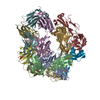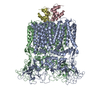+ Open data
Open data
- Basic information
Basic information
| Entry | Database: EMDB / ID: EMD-0366 | |||||||||
|---|---|---|---|---|---|---|---|---|---|---|
| Title | Imp7:ImpB:H1.0 | |||||||||
 Map data Map data | Imp7:Impu03B2:H1 | |||||||||
 Sample Sample |
| |||||||||
 Keywords Keywords | Imp7:ImpB:H1.0 / Importin / Histone H1 / nuclear import / disordered interactions / TRANSPORT PROTEIN | |||||||||
| Function / homology |  Function and homology information Function and homology informationRNA import into nucleus / Inhibition of nitric oxide production / mitotic chromosome movement towards spindle pole / endoplasmic reticulum tubular network / positive regulation of transcription regulatory region DNA binding / astral microtubule organization / establishment of mitotic spindle localization / Transport of Ribonucleoproteins into the Host Nucleus / negative regulation of DNA recombination / Regulation of cholesterol biosynthesis by SREBP (SREBF) ...RNA import into nucleus / Inhibition of nitric oxide production / mitotic chromosome movement towards spindle pole / endoplasmic reticulum tubular network / positive regulation of transcription regulatory region DNA binding / astral microtubule organization / establishment of mitotic spindle localization / Transport of Ribonucleoproteins into the Host Nucleus / negative regulation of DNA recombination / Regulation of cholesterol biosynthesis by SREBP (SREBF) / importin-alpha family protein binding / NS1 Mediated Effects on Host Pathways / NLS-dependent protein nuclear import complex / NLS-bearing protein import into nucleus / Apoptosis induced DNA fragmentation / nuclear localization sequence binding / Initiation of Nuclear Envelope (NE) Reformation / ribosomal protein import into nucleus / Nuclear import of Rev protein / chromosome condensation / Postmitotic nuclear pore complex (NPC) reformation / nuclear import signal receptor activity / nucleosomal DNA binding / Formation of Senescence-Associated Heterochromatin Foci (SAHF) / mitotic metaphase chromosome alignment / minor groove of adenine-thymine-rich DNA binding / mitotic spindle assembly / nuclear pore / nucleosome binding / transcription repressor complex / Assembly of the ORC complex at the origin of replication / Hsp90 protein binding / positive regulation of cholesterol biosynthetic process / euchromatin / chromatin DNA binding / small GTPase binding / ISG15 antiviral mechanism / specific granule lumen / cytoplasmic stress granule / protein import into nucleus / SARS-CoV-1 activates/modulates innate immune responses / Interferon alpha/beta signaling / structural constituent of chromatin / nuclear envelope / nucleosome / heterochromatin formation / nucleosome assembly / actin cytoskeleton / double-stranded DNA binding / nuclear membrane / ficolin-1-rich granule lumen / nuclear body / protein domain specific binding / Neutrophil degranulation / chromatin / enzyme binding / Golgi apparatus / RNA binding / extracellular exosome / extracellular region / zinc ion binding / nucleoplasm / nucleus / membrane / cytoplasm / cytosol Similarity search - Function | |||||||||
| Biological species |  Homo sapiens (human) / Homo sapiens (human) / | |||||||||
| Method | single particle reconstruction / cryo EM / Resolution: 6.2 Å | |||||||||
 Authors Authors | Bilokapic S / Ivic N | |||||||||
| Funding support | European Union,  Croatia, 2 items Croatia, 2 items
| |||||||||
 Citation Citation |  Journal: Mol Cell / Year: 2019 Journal: Mol Cell / Year: 2019Title: Fuzzy Interactions Form and Shape the Histone Transport Complex. Authors: Nives Ivic / Mia Potocnjak / Victor Solis-Mezarino / Franz Herzog / Silvija Bilokapic / Mario Halic /    Abstract: Protein transport into the nucleus is mediated by transport receptors. Import of highly charged proteins, such as histone H1 and ribosomal proteins, requires a dimer of two transport receptors. In ...Protein transport into the nucleus is mediated by transport receptors. Import of highly charged proteins, such as histone H1 and ribosomal proteins, requires a dimer of two transport receptors. In this study, we determined the cryo-EM structure of the Imp7:Impβ:H1.0 complex, showing that the two importins form a cradle that accommodates the linker histone. The H1.0 globular domain is bound to Impβ, whereas the acidic loops of Impβ and Imp7 chaperone the positively charged C-terminal tail. Although it remains disordered, the H1 tail serves as a zipper that closes and stabilizes the structure through transient non-specific interactions with importins. Moreover, we found that the GGxxF and FxFG motifs in the Imp7 C-terminal tail are essential for Imp7:Impβ dimerization and H1 import, resembling importin interaction with nucleoporins, which, in turn, promote complex disassembly. The architecture of many other complexes might be similarly defined by rapidly exchanging electrostatic interactions mediated by disordered regions. | |||||||||
| History |
|
- Structure visualization
Structure visualization
| Movie |
 Movie viewer Movie viewer |
|---|---|
| Structure viewer | EM map:  SurfView SurfView Molmil Molmil Jmol/JSmol Jmol/JSmol |
| Supplemental images |
- Downloads & links
Downloads & links
-EMDB archive
| Map data |  emd_0366.map.gz emd_0366.map.gz | 12 MB |  EMDB map data format EMDB map data format | |
|---|---|---|---|---|
| Header (meta data) |  emd-0366-v30.xml emd-0366-v30.xml emd-0366.xml emd-0366.xml | 17.9 KB 17.9 KB | Display Display |  EMDB header EMDB header |
| Images |  emd_0366.png emd_0366.png | 245.4 KB | ||
| Filedesc metadata |  emd-0366.cif.gz emd-0366.cif.gz | 7.6 KB | ||
| Archive directory |  http://ftp.pdbj.org/pub/emdb/structures/EMD-0366 http://ftp.pdbj.org/pub/emdb/structures/EMD-0366 ftp://ftp.pdbj.org/pub/emdb/structures/EMD-0366 ftp://ftp.pdbj.org/pub/emdb/structures/EMD-0366 | HTTPS FTP |
-Validation report
| Summary document |  emd_0366_validation.pdf.gz emd_0366_validation.pdf.gz | 430.3 KB | Display |  EMDB validaton report EMDB validaton report |
|---|---|---|---|---|
| Full document |  emd_0366_full_validation.pdf.gz emd_0366_full_validation.pdf.gz | 429.9 KB | Display | |
| Data in XML |  emd_0366_validation.xml.gz emd_0366_validation.xml.gz | 5.5 KB | Display | |
| Data in CIF |  emd_0366_validation.cif.gz emd_0366_validation.cif.gz | 6.4 KB | Display | |
| Arichive directory |  https://ftp.pdbj.org/pub/emdb/validation_reports/EMD-0366 https://ftp.pdbj.org/pub/emdb/validation_reports/EMD-0366 ftp://ftp.pdbj.org/pub/emdb/validation_reports/EMD-0366 ftp://ftp.pdbj.org/pub/emdb/validation_reports/EMD-0366 | HTTPS FTP |
-Related structure data
| Related structure data |  6n88MC  0367C  0368C  6n89C C: citing same article ( M: atomic model generated by this map |
|---|---|
| Similar structure data |
- Links
Links
| EMDB pages |  EMDB (EBI/PDBe) / EMDB (EBI/PDBe) /  EMDataResource EMDataResource |
|---|---|
| Related items in Molecule of the Month |
- Map
Map
| File |  Download / File: emd_0366.map.gz / Format: CCP4 / Size: 18.1 MB / Type: IMAGE STORED AS FLOATING POINT NUMBER (4 BYTES) Download / File: emd_0366.map.gz / Format: CCP4 / Size: 18.1 MB / Type: IMAGE STORED AS FLOATING POINT NUMBER (4 BYTES) | ||||||||||||||||||||||||||||||||||||||||||||||||||||||||||||
|---|---|---|---|---|---|---|---|---|---|---|---|---|---|---|---|---|---|---|---|---|---|---|---|---|---|---|---|---|---|---|---|---|---|---|---|---|---|---|---|---|---|---|---|---|---|---|---|---|---|---|---|---|---|---|---|---|---|---|---|---|---|
| Annotation | Imp7:Impu03B2:H1 | ||||||||||||||||||||||||||||||||||||||||||||||||||||||||||||
| Projections & slices | Image control
Images are generated by Spider. | ||||||||||||||||||||||||||||||||||||||||||||||||||||||||||||
| Voxel size | X=Y=Z: 1.43 Å | ||||||||||||||||||||||||||||||||||||||||||||||||||||||||||||
| Density |
| ||||||||||||||||||||||||||||||||||||||||||||||||||||||||||||
| Symmetry | Space group: 1 | ||||||||||||||||||||||||||||||||||||||||||||||||||||||||||||
| Details | EMDB XML:
CCP4 map header:
| ||||||||||||||||||||||||||||||||||||||||||||||||||||||||||||
-Supplemental data
- Sample components
Sample components
-Entire : Imp7:ImpB:H1.0
| Entire | Name: Imp7:ImpB:H1.0 |
|---|---|
| Components |
|
-Supramolecule #1: Imp7:ImpB:H1.0
| Supramolecule | Name: Imp7:ImpB:H1.0 / type: complex / ID: 1 / Parent: 0 / Macromolecule list: all |
|---|---|
| Source (natural) | Organism:  Homo sapiens (human) Homo sapiens (human) |
-Macromolecule #1: MGC52556 protein
| Macromolecule | Name: MGC52556 protein / type: protein_or_peptide / ID: 1 / Number of copies: 1 / Enantiomer: LEVO |
|---|---|
| Source (natural) | Organism: |
| Molecular weight | Theoretical: 119.553156 KDa |
| Recombinant expression | Organism:  |
| Sequence | String: MDPNILIEAL RGTMDPALRE AAERQLNESH KSLHFVSTLL QITMSEQLEL PVRQAGVIYL KNMITQYWPD REVTPGELPP HTIPEEDRH CIRENIVEAI MHSPELIRVQ LTTCIHHIIK HDYPNRWTAV VEKIGFYLQS DNSACWLGIL LCLYQLVKNY E YKKPEERS ...String: MDPNILIEAL RGTMDPALRE AAERQLNESH KSLHFVSTLL QITMSEQLEL PVRQAGVIYL KNMITQYWPD REVTPGELPP HTIPEEDRH CIRENIVEAI MHSPELIRVQ LTTCIHHIIK HDYPNRWTAV VEKIGFYLQS DNSACWLGIL LCLYQLVKNY E YKKPEERS PLIAAMQHFL PMLKDRYIQL LADPSEQSVL IQKQIFKIFY ALVQYTLPLE LINQQNLAEW IEILKTVVDR DV PAETLQV DEDDRPELPW WKCKKWALHI LARLFERYGS PGNVSKEYND FAEVFLKAFA VGVQQVLLKV LYQYKEKQYI APR VLQQTL NYFNQGVSHA VTWKNLKPHI QGIIQDVIFP LMCYTDSDED LWQEDPYEYI RMKFDVFEDF ISPTTAAQTL LFTS CSKRK EVLQKTMGFC YQILTEPAAD PRKKDGALHM IGSLAEILLK KKIYKDQMEF MLQNHVFPLF SSELGYMRAR ACWVL HYFC EVKFKVDQNL QTALELTRRC LIDDREMPVK VEAAIALQVL ISNQEKAKEY IVPFIRPVMQ ALLHIIRETE NDDLTN VIQ KMICEYSEEV TPIAVEMTQH LAMTFNQVIQ TGPDEEGSDD KAVTAMGILN TIDTLLSVVE DHKEITQQLE GICLQVI GT VLQQHVLEFY EEIFSLAHSL TCQQVSPQMW QLLPLVFDIF QQDGFDYFTD MMPLLHNYVT VDTDTLLSDT KYLEMIYS M CKKILTGVAG EDAECHAAKL LEVVILQCKG RGIDQVIPLF VEAALERLTR EVKTSELRTM CLQVAIAALY YSPPLLFNT LENLRFPNNE EPVTNHFIKQ WLNDVDCFLG LHDRKICVLG LCALIELEQR PQVLNQMSSQ ILPAFLLLFN GLKRAYACHA EQENDSDDD GDGEDDEDAA ELGSDEDDID EEGQEYLEIL AKQAGEDGDD EDWEDDDAEE TALEGYTTLL DDEDTPIDEY Q IFKAIFQK LQGRDPVWYQ ALTQGLNEDQ GKQLQDIATL ADQRRAAHES KMIEKHGGYK FNAPVVPSTF NFGNPAPGMN UniProtKB: Importin 7 L homeolog |
-Macromolecule #2: Importin subunit beta-1
| Macromolecule | Name: Importin subunit beta-1 / type: protein_or_peptide / ID: 2 / Number of copies: 1 / Enantiomer: LEVO |
|---|---|
| Source (natural) | Organism:  Homo sapiens (human) Homo sapiens (human) |
| Molecular weight | Theoretical: 97.257812 KDa |
| Recombinant expression | Organism:  |
| Sequence | String: MELITILEKT VSPDRLELEA AQKFLERAAV ENLPTFLVEL SRVLANPGNS QVARVAAGLQ IKNSLTSKDP DIKAQYQQRW LAIDANARR EVKNYVLQTL GTETYRPSSA SQCVAGIACA EIPVNQWPEL IPQLVANVTN PNSTEHMKES TLEAIGYICQ D IDPEQLQD ...String: MELITILEKT VSPDRLELEA AQKFLERAAV ENLPTFLVEL SRVLANPGNS QVARVAAGLQ IKNSLTSKDP DIKAQYQQRW LAIDANARR EVKNYVLQTL GTETYRPSSA SQCVAGIACA EIPVNQWPEL IPQLVANVTN PNSTEHMKES TLEAIGYICQ D IDPEQLQD KSNEILTAII QGMRKEEPSN NVKLAATNAL LNSLEFTKAN FDKESERHFI MQVVCEATQC PDTRVRVAAL QN LVKIMSL YYQYMETYMG PALFAITIEA MKSDIDEVAL QGIEFWSNVC DEEMDLAIEA SEAAEQGRPP EHTSKFYAKG ALQ YLVPIL TQTLTKQDEN DDDDDWNPCK AAGVCLMLLA TCCEDDIVPH VLPFIKEHIK NPDWRYRDAA VMAFGCILEG PEPS QLKPL VIQAMPTLIE LMKDPSVVVR DTAAWTVGRI CELLPEAAIN DVYLAPLLQC LIEGLSAEPR VASNVCWAFS SLAEA AYEA ADVADDQEEP ATYCLSSSFE LIVQKLLETT DRPDGHQNNL RSSAYESLME IVKNSAKDCY PAVQKTTLVI MERLQQ VLQ MESHIQSTSD RIQFNDLQSL LCATLQNVLR KVQHQDALQI SDVVMASLLR MFQSTAGSGG VQEDALMAVS TLVEVLG GE FLKYMEAFKP FLGIGLKNYA EYQVCLAAVG LVGDLCRALQ SNIIPFCDEV MQLLLENLGN ENVHRSVKPQ ILSVFGDI A LAIGGEFKKY LEVVLNTLQQ ASQAQVDKSD YDMVDYLNEL RESCLEAYTG IVQGLKGDQE NVHPDVMLVQ PRVEFILSF IDHIAGDEDH TDGVVACAAG LIGDLCTAFG KDVLKLVEAR PMIHELLTEG RRSKTNKAKT LATWATKELR KLKNQA UniProtKB: Importin subunit beta-1 |
-Macromolecule #3: Histone H1.0
| Macromolecule | Name: Histone H1.0 / type: protein_or_peptide / ID: 3 / Number of copies: 1 / Enantiomer: LEVO |
|---|---|
| Source (natural) | Organism:  Homo sapiens (human) Homo sapiens (human) |
| Molecular weight | Theoretical: 20.927182 KDa |
| Recombinant expression | Organism:  |
| Sequence | String: MTENSTSAPA AKPKRAKASK KSTDHPKYSD MIVAAIQAEK NRAGSSRQSI QKYIKSHYKV GENADSQIKL SIKRLVTTGV LKQTKGVGA SGSFRLAKSD EPKKSVAFKK TKKEIKKVAT PKKASKPKKA ASKAPTKKPK ATPVKKAKKK LAATPKKAKK P KTVKAKPV ...String: MTENSTSAPA AKPKRAKASK KSTDHPKYSD MIVAAIQAEK NRAGSSRQSI QKYIKSHYKV GENADSQIKL SIKRLVTTGV LKQTKGVGA SGSFRLAKSD EPKKSVAFKK TKKEIKKVAT PKKASKPKKA ASKAPTKKPK ATPVKKAKKK LAATPKKAKK P KTVKAKPV KASKPKKAKP VKPKAKSSAK RAGKKK UniProtKB: Histone H1.0 |
-Experimental details
-Structure determination
| Method | cryo EM |
|---|---|
 Processing Processing | single particle reconstruction |
| Aggregation state | particle |
- Sample preparation
Sample preparation
| Buffer | pH: 7 |
|---|---|
| Grid | Details: unspecified |
| Vitrification | Cryogen name: ETHANE |
- Electron microscopy
Electron microscopy
| Microscope | FEI TITAN KRIOS |
|---|---|
| Image recording | Film or detector model: GATAN K2 BASE (4k x 4k) / Average electron dose: 80.0 e/Å2 |
| Electron beam | Acceleration voltage: 300 kV / Electron source:  FIELD EMISSION GUN FIELD EMISSION GUN |
| Electron optics | Illumination mode: FLOOD BEAM / Imaging mode: BRIGHT FIELD |
| Experimental equipment |  Model: Titan Krios / Image courtesy: FEI Company |
 Movie
Movie Controller
Controller
























 Z (Sec.)
Z (Sec.) Y (Row.)
Y (Row.) X (Col.)
X (Col.)





















